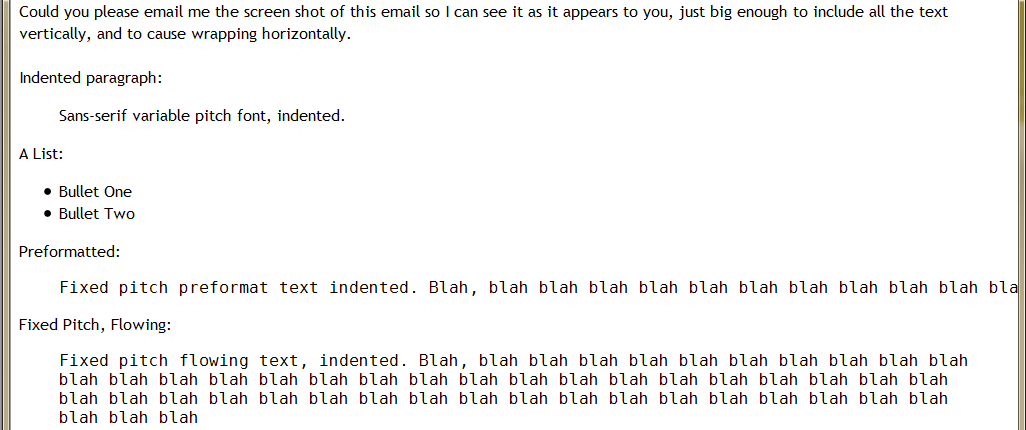12
3
I have had a long-term ongoing battle in having nicely formatted emails sent in Thunderbird totally destroyed by MS Outlook. Are there any settings in either program which can resolve disagreements in layout and font selection?
By way of example, as a test I sent this:

and my coworker saw this:

The full source of the email sent is this:
From - Mon Nov 15 13:58:11 2010
X-Mozilla-Status: 0001
X-Mozilla-Status2: 00800000
X-Mozilla-Keys:
Message-ID: <4CE1ACF1.2060804@***redacted***>
Date: Mon, 15 Nov 2010 13:58:09 -0800
From: ***redacted***
Organization: ***redacted***
User-Agent: Mozilla/5.0 (Windows; U; Windows NT 6.1; en-US; rv:1.9.2.12) Gecko/20101027 Thunderbird/3.1.6
MIME-Version: 1.0
To: ***redacted***
Subject: Font used in email from me
X-Priority: 5 (Lowest)
Content-Type: text/html; charset=UTF-8
Content-Transfer-Encoding: 7bit
<!DOCTYPE HTML PUBLIC "-//W3C//DTD HTML 4.01 Transitional//EN">
<html>
<head>
<meta http-equiv="content-type" content="text/html; charset=UTF-8">
</head>
<body bgcolor="#ffffff" text="#000000">
<span id="IDstID">***redacted***,<br>
<br>
Could you please email me the screen shot of this email so I can
see it as it appears to you, just big enough to include all the
text vertically, and to cause wrapping horizontally.<br>
<br>
Indented paragraph:<br>
</span>
<blockquote>Sans-serif variable pitch font, indented.<br>
</blockquote>
A List:<br>
<ul>
<li>Bullet One</li>
<li>Bullet Two</li>
</ul>
Preformatted:<br>
<blockquote>
<pre>Fixed pitch preformat text indented. <tt>Blah,</tt><tt> blah</tt><tt> blah</tt><tt> blah</tt><tt> blah</tt><tt> blah</tt><tt> blah</tt><tt> blah</tt><tt> blah</tt><tt> blah</tt><tt> blah</tt><tt> blah</tt><tt> blah</tt><tt> blah</tt><tt> blah</tt><tt> blah</tt><tt> blah</tt><tt> blah</tt><tt> blah</tt><tt> blah</tt><tt> blah</tt><tt> blah</tt><tt> blah</tt><tt> blah</tt><tt> blah</tt><tt> blah</tt><tt> blah</tt><tt> blah</tt><tt> blah</tt><tt> blah</tt><tt> blah</tt><tt> blah</tt><tt> blah</tt><tt> blah</tt><tt> blah</tt><tt> blah</tt><tt> blah</tt><tt> blah</tt><tt> blah</tt><tt> blah</tt><tt> blah</tt><tt> blah</tt><tt> blah</tt><tt> blah</tt><tt> blah</tt><tt> blah</tt><tt> blah</tt><tt> blah</tt><tt> blah</tt><tt> blah</tt></pre>
</blockquote>
Fixed Pitch, Flowing:<br>
<blockquote><tt>Fixed pitch flowing text, indented. Blah,</tt><tt>
blah</tt><tt> blah</tt><tt> blah</tt><tt> blah</tt><tt> blah</tt><tt>
blah</tt><tt> blah</tt><tt> blah</tt><tt> blah</tt><tt> blah</tt><tt>
blah</tt><tt> blah</tt><tt> blah</tt><tt> blah</tt><tt> blah</tt><tt>
blah</tt><tt> blah</tt><tt> blah</tt><tt> blah</tt><tt> blah</tt><tt>
blah</tt><tt> blah</tt><tt> blah</tt><tt> blah</tt><tt> blah</tt><tt>
blah</tt><tt> blah</tt><tt> blah</tt><tt> blah</tt><tt> blah</tt><tt>
blah</tt><tt> blah</tt><tt> blah</tt><tt> blah</tt><tt> blah</tt><tt>
blah</tt><tt> blah</tt><tt> blah</tt><tt> blah</tt><tt> blah</tt><tt>
blah</tt><tt> blah</tt><tt> blah</tt><tt> blah</tt><tt> blah</tt><tt>
blah</tt><tt> blah</tt><tt> blah</tt><tt> blah</tt></blockquote>
<span id="IDstID">-- <br>
***redacted***<br>
***redacted***<br>
<a class="moz-txt-link-freetext" href="http://www.***redacted***.com">http://www.***redacted***.com</a><br>
</span>
</body>
</html>
One thing might help in identifying this issue is to compare the full headers for emails sent from Outlook to Thunderbird, and vice-versa. Outlook may be setting/expecting a header that Thunderbird does not normally set. Since these look to be HTML/RTF emails, something about the
Content-typeor encoding used might be useful in getting more information. – roguesys – 2010-11-15T23:35:06.820Content-type for outgoing mail is set for UTF-8 in Thunderbird. These are newly composed emails, and not replies or forwards. – Lawrence Dol – 2010-11-15T23:41:48.123
I've added the email source, which shows such things as content type, encoding and TB versions. – Lawrence Dol – 2010-11-15T23:47:08.633